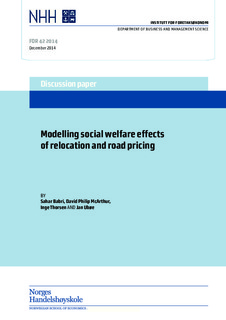| dc.contributor.author | Babri, Sahar | |
| dc.contributor.author | McArthur, David Philip | |
| dc.contributor.author | Thorsen, Inge | |
| dc.contributor.author | Ubøe, Jan | |
| dc.date.accessioned | 2014-12-18T10:19:36Z | |
| dc.date.available | 2014-12-18T10:19:36Z | |
| dc.date.issued | 2014-12 | |
| dc.identifier.issn | 1500-4066 | |
| dc.identifier.uri | http://hdl.handle.net/11250/227760 | |
| dc.description.abstract | Road pricing is a popular congestion reduction strategy. However, there may be wider impacts
associated with a road toll. We consider a factor which is sometimes overlooked, namely that workers
and rms may choose to change location in response to changes in the travel costs. A spatial equilibrium
model is used to analyse suboptimalities in road pricing which may occur if relocations are ignored.
We show that such suboptimalities can be substantial. The advantage of the model we use over many
existing approaches is that it is easy to implement, and requires very little data. | nb_NO |
| dc.language.iso | eng | nb_NO |
| dc.publisher | FOR | nb_NO |
| dc.relation.ispartofseries | Discussion paper;42/14 | |
| dc.subject | relocation | nb_NO |
| dc.subject | road pricing | nb_NO |
| dc.subject | congestion | nb_NO |
| dc.subject | spatial equilibrium modelling | nb_NO |
| dc.subject | LUTI modelling | nb_NO |
| dc.title | Modelling social welfare effects of relocation and road pricing | nb_NO |
| dc.type | Working paper | nb_NO |
